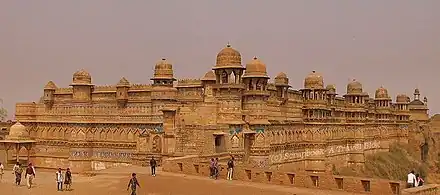Tomar (Rajput clan)
Tomar (also called Tomara) is a clan name, some members of which ruled parts of North India at different times. They are Rajputs and claim Chandravanshi descent.
Most of their population is primarily concentrated in Delhi, Haryana-Torawati and Western UP. There exists 84 villages of Tomars in Western UP alone. Besides,few areas in Northern Madhya Pradesh like Morena, Bhind and Gwalior is referred to as "Tomargarh" meaning "Fort of Tomars" due to quite large population of Tomar Rajputs outside Delhi and its surrounding areas.[1]
History
The Tomar clan claim descent from Chandravanshi dynasty, naming the Mahabharata warrior Arjuna among their forebears.[2]
The earliest extant historical reference to the Tomaras (the Sanskrit form of "Tomar") occurs in the Pehowa inscription of the Gurjara-Pratihara king Mahendrapala I (r. c. 885-910 CE).[3] This undated inscription suggests that the Tomara chief Gogga was a vassal of Mahendrapala I.[4]
Tomaras of Delhi
During 9th-12th century, the Tomaras of Delhi ruled parts of the present-day Delhi, Haryana, Western Uttar Pradesh, Gwalior and parts of Rajasthan.[5] Much of the information about this dynasty comes from bardic legends of little historical value, and therefore, the reconstruction of their history is difficult.[6] According to the bardic tradition, the dynasty's founder Anangapal Tomar (that is Anangapala I Tomara) founded Delhi in 736 CE.[3] The bardic legends also state that the last Tomara King (also named Anangapal) passed on the throne of Delhi to his son-in-law Prithviraj Chauhan. This claim is subject to interpretation: historical evidence shows that Prithviraj inherited Delhi from his father Someshvara.[6] According to the Bijolia inscription of Someshvara, his brother Vigraharaja IV had captured Dhillika (Delhi) and Ashika (Hansi); he probably defeated a Tomara ruler.[7]
Tomaras of Gwalior

The Tomaras of Gwalior ruled an area north of Gwalior known as the Tonwargarh tract. The most notable of these rulers was Man Singh Tomar (1486-1517).[8]
References
- "Guns rule 'badlands' of Bhind-Morena". Zeenews. Retrieved 9 August 2014.
- Singh, David Emmanuel (2012). Islamization in Modern South Asia: Deobandi Reform and the Gujjar Response. Walter de Gruyter. p. 55. ISBN 9781614511854.
- Sailendra Nath Sen 1999, p. 339.
- Dilip Kumar Ganguly 1984, pp. 116–117.
- Upinder Singh 2008, p. 571.
- D. C. Ganguly 1981, p. 704.
- Dilip Kumar Ganguly 1984, p. 117.
- Kolff, Dirk H. A. (2002) [First published 1990]. Naukar, Rajput, and Sepoy: The Ethnohistory of the Military Labour Market of Hindustan, 1450-1850. Cambridge University Press. p. 89. ISBN 978-0-52152-305-9.
Bibliography
- D. C. Ganguly (1981). R. S. Sharma (ed.). A Comprehensive History of India (A. D. 300-985). Vol. 3, Part 1. Indian History Congress / Orient Longmans.
- Dilip Kumar Ganguly (1984). History and Historians in Ancient India. Abhinav. ISBN 978-0-391-03250-7.
- Sailendra Nath Sen (1999). Ancient Indian History and Civilization. New Age. ISBN 9788122411980.
- Upinder Singh (2008). A History of Ancient and Early Medieval India: From the Stone Age to the 12th Century. Pearson Education India. ISBN 978-81-317-1120-0.
